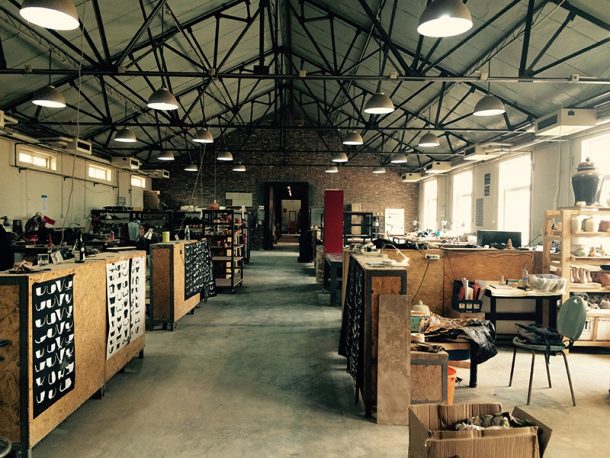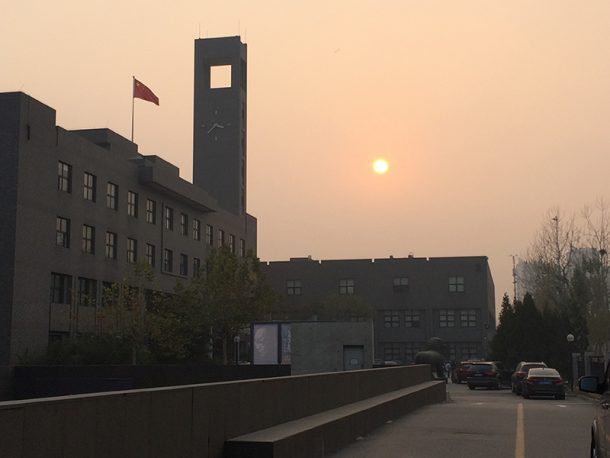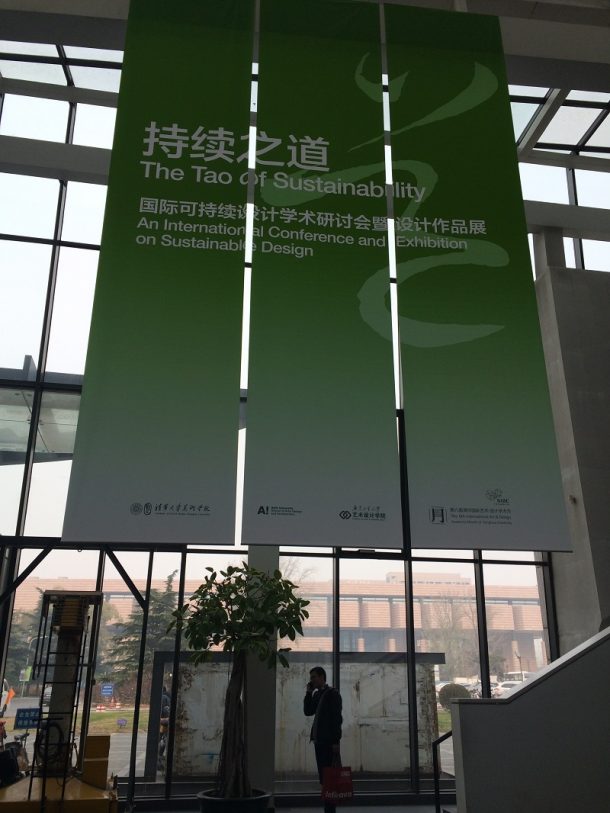For the Shekou Project, Luisa E. Mengoni, Brendan Cormier, Sunny Cheung, and Rong Zhao travelled to five cities in two weeks, to research the current state of design in China – to see how design is produced, perceived, consumed, and discussed across the country. All of this, to figure out how the V&A, through its work with the Shekou Design Museum, can contribute in a meaningful way to the broader ambition of China to become a significant design presence in the 21st century. Over the next few weeks we’ll be publishing reports from each of those cities – Hong Kong, Shenzhen, Shanghai, Hangzhou, and Beijing – and the thoughts and observations gained.
Beijing was our next stop after Shanghai. This was already back in November. I mention this not because the trip feels quite distant and lost in memory now, but Beijing always comes to my mind in grey. Grey are the bricks in the traditional ‘hutong’, the narrow traditional alleys that used to cut the city in a perfect grid, and grey are also the concrete apartment blocks, the roads, the dust and, most importantly, the sky. The thick grey patina that seems to be stuck on your head or in front of you while in Beijing is only temporarily lifted during very windy days; Beijing people now say ‘waiting for the wind [to breath]’ 等大风来. Another exception to the ‘grey rule’ is when the output of factories and the circulation of cars are temporarily stopped or limited, as it happened at the time of the Olympic Games or, more recently, during APEC, a major economic summit attended by presidents from all over Asia, as well as Obama and Putin. On this occasion the sky apparently acquired a more natural colour, wittingly renamed ‘APEC blue’. Pollution is probably the most pressing problem in Beijing right now, an issue that is having a direct impact on people’s lives and is at the core of many public debates and government policies directed to reduce the causes of environmental degradation and to improve urban life for many (Beijing’s population is over 20 million). Gas masks of all types now abound on-line and even at a recent catwalk at a Beijing fashion show the designer Qiaodan Yin Peng 乔丹尹鹏 showed trendy outfits with matching gas masks.

But despite all its problems Beijing retains an undoubtable charm that we will unveil during our visit. The first destination is on our way from the airport. We drive on the large motorway running through the enormous suburban area of north Beijing; on the horizon never ending rows and clusters of high apartment blocks. All major universities in the capital are still concentrated on the periphery, between the third and fourth ring, far away from the political and administrative centre of the capital, although now they can be reached much more easily with the Beijing underground, one of the largest in the world.
Central Academy of Fine Arts (CAFA) 中央美术学院
The Central Academy of Fine Arts (CAFA) and the Chinese Academy of Art (CAA) in Hangzhou are the most important venues in China for the study of art and design. Before reaching the main campus of CAFA we stop at one of its branches, the Institute of City Design (中央美术学院城市设计学院), a former vocational school that intends to offer a design programme more specifically related to cities and urban life. Areas of study include product design, urban planning, design for public spaces, industrial design and digital design. Nick Geankoplis, tutor of studio pottery, and Bo Wen, lecturer in Chinese ceramics, show us the Ceramics section, part of the Lifestyle and Design department, as well as the furniture making workshop, the metalwork workshop and the urban planning section.

Nick is on a three-year secondment from Alfred University, New York, as part of an agreement between the two universities to develop a more product-oriented curriculum. Our general impression is that teaching still focuses on craft and traditional hand-made techniques, with more limited space for conceptual approaches and theory-based (or problem solving) practices. Once again we are confronted with an idea of design closely associated to craftsmanship, a peculiar characteristic of design practices all over Asia.

On the main campus of CAFA we have a very interesting conversation with Prof Xu Ping许平, President of CAFA Graduate School and Vice-Dean of the Design Institute (设计学院). Xu Ping, co-author of a special study on design education in China in the years 2007-2012, tells us that in 2012 there were 1,917 vocational and academic design institutes at university and high-school level in China. That year 574.000 students enrolled in design courses, making the total number of design students in China close to two millions. Such a large number has made necessary the recruitment of more teachers, and around 100,000 are currently needed. The problem is that many instructors still have a traditional approach to design or have not fully grasped the challenges and needs of design practice in China.
Xu Ping confirms that design has traditionally been conceived in China as a form of craft or decorative art and taught in Fine Art schools. It was only in the 1980s that a new idea of design, particularly connected with product and industrial design, was introduced in the country, coinciding with the development of manufacturing industries in the special economic zones (SEZ). Here factories began to produce goods for foreign brands or low-cost items for export, the famous ‘made in China’. Domestic imitations of foreign models and early attempts to define the specific requirements of product design followed suit. Since then design has gradually grown as a discipline in Chinese universities and, especially in the top ones, attempts are now made to develop innovative and problem-solving approaches. Government directives are also pushing to encourage more innovation and eventually prompt a transition from ‘made in China’ to ‘create in China’. This will surely take time and will most likely co-exist with a parallel direction in the design world, where Asian craftsmanship and identity are experiencing a new revival.
Qinghua University 清华大学
Qinghua University is a vibrant place. As soon as we arrive we are welcomed by a huge poster promoting a conference on design and sustainability entitled ‘The Tao of Sustainability持续之道– A conference and exhibition on sustainable design’. What a fantastic title and a promising intellectual subject. The Institute of Design, now subdivided in several departments such as Chinese Arts and Crafts, Visual and Communication Design, Product Design etc., was originally the Zhongyang Gongyi Meishu Xueyuan 中央工艺美术学院, which became part of Qinghua University from the 1990s. Another clear example of how design has traditionally been associated with crafts and fine arts. Around 400 students are now enrolled each year.

In Qinghua we meet Prof Li Degeng 李德耕, Vice Dean of the Department of Visual and Communication Design, who regularly works in Shenzhen and has already contributed to several design exhibitions, such as the Beijing International Design Triennale (2011), the Shenzhen Design Triennale (2012, 2015) and the Shenzhen Biennale of Urbanism and Architecture (2014). Prof Li is very enthusiastic and dynamic and understands the importance of a sound curatorial approach when developing an exhibition. He remarks again the crucial role that universities can play in teaching design by raising interesting questions and encouraging innovative approaches, but he also reminds us that revitilising and promoting old traditional techniques is another fundamental aspect of current design practices in China. Something that can be seen in the rest of Asia too.
We talk extensively about curatorial choices, interpretation and audiences, and the importance of offering clear ‘entry points’ to the general public, but also the opportunity of understanding creative thinking and processes through objects. Shenzhen seems to be an ideal place to experiment with new ideas and approaches. Before leaving Li Degeng takes us around all the departments; the vibrancy of the place makes me think that the new Dao of Design will probably start from Qinghua.
Beijing Center for the Arts (BCA) 天安时间当台艺术中心
We spend the late afternoon at the Beijing Center for the Arts http://www.beijingcenterforthearts.com/, a gallery space occupying an old courtyard in the Qianmen area. The current exhibition ‘Chengnan Project – Qianmen East Area 2014’ 城难设划-前门东区2014 focuses on the problem of preservation and rehabilitation of the traditional ‘hutong’ and their courtyard houses, a characteristic urban lay-out that used to be both the physical and immaterial soul of old Beijing, until its gradual demolition from the 1990s. The sign 宅 (to demolish) marked on the walls of the courtyards became synonymous with the unstoppable advance of developers in the heart of the city and the hopeless resistance of the residents. Only recently there has been a slight change in heritage awareness and attempts are made to protect what is left. The exhibition at BCA seems to respond to such an urgency presenting projects and reflections by different architectural practices such as URBANUS, GROUND X3, Jiakun Architects and MVRDV. Some works are truly striking, such as the installation of floating courtyards by MVRDV, who have also published a book with a full range of alternative interventions. Neri & Hu place their model in the centre of a circle of chairs, each with a tag presenting their proud owners, old ‘hutong’ residents; I am caught by the poignancy of their personal stories that remind me of the very interesting research project on oral history in the ‘hutong’ by Harriet Evans at the University of Westminster. The scale of the demolition is dramatically visualised by an enlarged map of Beijing dated 1750 where red marks delineate the areas of the city as we know it now.

And more…
We spend the rest of our time in Beijing visiting museums and galleries and seeing friends working in the ‘field’. In our evening in the ‘hutong’ we meet Cruz Garcia and Nathalie Frankowski, who have established a small but very active gallery called Intelligentsia, where they present a mix of Chinese and foreign artists; they also have an independent architecture practice What About It Think Tank www.waithinktang.com.
We also meet Jeffrey Miller, who, together with Tom Schmidt, has established RecycledChina, a company which makes tiles and panels by mixing discarded porcelain from factories or broken bricks from demolition sites with melted metal www.recycledchina.com.
In our quick visit to the Red Gate Gallery 红门画廊 the director and founder Brian Wallace shows their current Buddhism-inspired exhibition ‘Zhongyin’s Icons’ by Shi Zhongyin, who has spent a few years researching and developing ideas for his works and installations. The Red Gate Gallery also has a successful artists in residence program www.redgategallery.com. We only touch base at the Today Museum 今日美术馆, where we catch the surreal sculptures in white resin made by Qu Guangci reflecting the grotesque extremes of a controlled and regimented society www.todayartmuseum.com. And finally, we take some time to browse a few galleries in 798, including my favourite ones: Beijing Commune 北京公社 www.beijingcommune.com and the Ullens Center of Contemporary Art (UCCA) where we have a chat with the director Philip Tinari www.ucca.org.cn.
We leave Beijing with several suggestions, ideas and also unresolved questions, but we hope to come back soon for another round of discussions. For the time being we have established some key-points that will surely help in defining the role that the V&A Gallery at Shekou can play in the field of Chinese design as well as in thinking about our possible audiences.